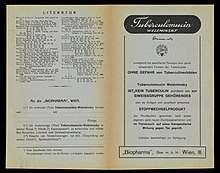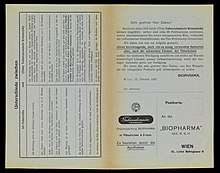Friedrich Weleminsky
Dr Joseph Friedrich ("Fritz") Weleminsky (20 January 1868, in Golčův Jeníkov – 1 January 1945, in London), was a physician, a scientist and a privatdozent in Hygiene (now called Microbiology) at the German University, Prague[note 1] who, in the early 20th century, created an alternative treatment for tuberculosis, tuberculomucin Weleminsky.[1]
Dr Friedrich Weleminsky | |
|---|---|
 Portrait picture of Friedrich & Jenny Weleminsky c. 1905–1910 | |
| Born | 20 January 1868 |
| Died | 1 January 1945 (aged 76) London, England |
| Nationality | Austrian (from birth); British (from 1940s) |
| Education | Kreuzschule, Dresden, Germany |
| Alma mater | Charles University (The German University, Prague) |
| Occupation | Physician, scientist and a Privatdozent in Hygiene (now called Microbiology) |
| Spouse(s) | Jenny Weleminsky, née Elbogen |
| Children | Three daughters and one son: Marianne; Anton; Eliesabeth (Jardenah); Dorothea (Leah) |
| Parent(s) | Jacob Weleminsky and Bertha Kohn |
| Medical career | |
| Institutions | Charles University (The German University, Prague) |
| Notable works | Developing tuberculomucin Weleminsky, a treatment for tuberculosis |



Early life and education
He was born into a Jewish family on 20 January 1868 at Golčův Jeníkov in Bohemia, which was then part of the Austrian Empire and is now in the Czech Republic. His parents were Jacob Weleminsky (1834–1905), a general medical practitioner (GP) in Golčův Jeníkov, and his wife Bertha (née Kohn; 1844–1914).[2] Friedrich was their second child; he had an elder sister, Paula (1867–1936), who in 1888 married a Dresden lawyer, Felix Popper, and a younger brother, Josef ("Pepi") (1870–1937) who, like Friedrich, studied medicine in Prague and who went on to become a laryngologist.
The family moved to Dresden in 1879 when Jacob obtained a position as GP there, and later to Prague. Friedrich attended the Kreuzschule in Dresden and studied medicine in Prague.
Career
Friedrich Weleminsky enrolled in the medical faculty of the German University in Prague in 1893 and obtained a habilitation qualification as Dr.Med. in 1900.[3] He was appointed to a teaching post in the university's medical faculty as a privatdozent in Hygiene in July 1900.[3]
During the First World War, Weleminsky was in charge of the reserve hospital "Halicz" which was stationed in various parts of Austria and Hungary. While stationed in Kleinreifling, a village in the district of Steyr-Land in Upper Austria, he successfully brought a local typhoid epidemic under control, for which he was made an Ehrenbürger of Weyer.[4]
Tuberculomucin Weleminsky
Weleminsky's particular area of interest was vaccination against tuberculosis. In 1935, an editorial in the American Journal of Clinical Pathology cited one of his articles[5] as providing "a good review of the voluminous literature accumulated on BCG".[6]
In 1912 Weleminsky, who was then second assistant to Ferdinand Hueppe, the head of the Institute for Hygiene at the German University of Prague, published his discovery of a new treatment for tuberculosis, which he named tuberculomucin (Tbm).[7][8] It was tested on guinea pigs,[7][9] with number 1769 being the first to survive due to the treatment in 1909.[7][10] He also used tuberculomucin Weleminsky[11] (also spelt tuberkulomucin Weleminsky[12] and tuberkulomuzin Weleminsky)[13] to treat cattle which he kept at his country retreat, Schloss Thalheim.
More than 60 papers were published in German describing tuberculomucin's use in humans, but very few of them were read by an English-speaking audience. By the mid-1920s it was known as tuberculomucin Weleminsky and at least two companies were involved in producing and marketing the treatment.[7][note 2] In 1938, Sanders, a Belgian pharmaceutical company, planned to manufacture Tbm and to make it available in Western Europe and other parts of the developed world. However, Weleminsky fled from Prague in 1939, a couple of weeks before the Nazi invasion of Czechoslovakia, and these plans and further development of the treatment ceased.[14]
Personal and family life
On 4 December 1905 he married Jenny Elbogen (1882–1957), at her parents' country home, Schloss Thalheim, Lower Austria.[note 3] The married couple lived in Prague and at Schloss Thalheim,[1] which Jenny inherited from her father after his death in 1918 and which they ran as a model dairy farm.
They had four children together. Their eldest daughter, Marianne (born 1906), and their son, Anton[note 4] (born 1908), came to Britain just before the Second World War. Two of their daughters emigrated in the early 1930s to Mandatory Palestine where they took new names – Eliesabeth (born 1909) became Jardenah, and Dorothea (born 1912) was known as Leah. Like his wife, Friedrich Weleminsky was a secular Jew and an atheist but he did not share her opposition to Zionism. Jenny ceased all contact with the two daughters after they left Austria to live in Palestine, but Friedrich communicated with them clandestinely through their sister Marianne.
Facing Nazi persecution for being Jewish, Friedrich and Jenny Weleminsky found sanctuary in 1939 in Britain.[1][4]
Death and legacy
Friedrich Weleminsky died of pneumonia on 1 January 1945 at Fulham Hospital, London[4] and is buried at Golders Green Jewish Cemetery. His wife Jenny, who was 14 years younger, survived him by 12 years. Their grandchildren and great-grandchildren now live in Britain, Israel, Australia, Sweden and Germany.
In 2011, following an approach by Weleminsky's eldest granddaughter, Dr Charlotte Jones, a retired general practitioner, a team at the University College London's Department of Science and Technology Studies resumed research on tuberculomucin Weleminsky.[15]
Publications
- Basch, K; Weleminsky, Friedrich (1898). "Ueber die Ausscheidung von Krankheitserregern durch die Milch". Jahrb. f. Kinderheilk. 47, 105–115
- Weleminsky, Friedrich (1899). Über Sporenbildung bei Dematium pululans de Bary, 7pp.
- Weleminsky, Friedrich (1899). Ueber Akklimitisation in Grossstädten (On acclimisation in large cities), Oldenbourg: Munich. Off-print from Archiv für Hygiene, 26: 2
- Jadassohn, J; Pick, Walther; Weleminsky, Friedrich (1903). "Buchanzeigen und Besprechungen". Archiv für Dermatologie und Syphilis, 64(1): 149–160
- Weleminsky, Friedrich (1905). "Zur Pathogenese der Lungentuberkulose (On the pathogenesis of lung tuberculosis)". Klinische Wochenschrift (Clinical Weekly). Berlin, Springer-Verlag
- Weleminsky, Friedrich (1906)."Ueber Zuchtung von Mikroorganismen in stromenden Nahrboden". Zentralblatt fur Bakteriologie, Parasitenkunde und Infektionskrankheiten (Central Journal of Bacteriology, Parasitics, Infectious Diseases and Hygiene), 42: 1–7
- Weleminsky, Friedrich (1907). "Der Gang von Infektionen in den Lymphbahnen (The course of infections in the lymphatics)". Klinische Wochenschrift (Clinical Weekly). Berlin, Springer-Verlag
- Weleminsky, Friedrich (1912). "Ueber die Bildung von Elweiss und Mucin durch Tuberkelbacillen". Klinische Wochenschrift (Clinical Weekly). 28: 1–8 Berlin, Springer-Verlag
- Weleminsky, Friedrich (1914). "Tierversuche mit Tuberculomucin". Klinische Wochenschrift (Clinical Weekly). 18: 1–10 Berlin, Springer-Verlag
- Weleminsky, Friedrich (1928). "Filtrable form of tubercle bacilli". Zentralbl. f. d. gesam. Tuberk.Forsch. 28(5/6): 305–310
- Weleminsky, Friedrich (1930). "Die Immunisierung gegen Tuberkulose mit Calmette's BCG". Klinische Wochenschrift (Clinical Weekly). II: 1317–1320 Berlin, Springer-Verlag
- Weleminsky, Friedrich (1930). "Die B.C.G.-Literatur in französischer Sprache". Zentralbl. f. d. gesam. Tuberk.Forsch. 33: 129–135
See also
Note
- From 1882 to 1939, Charles University in Prague was divided into two institutions, one German-speaking and the other Czech-speaking. See https://www.lfhk.cuni.cz/Faculty/About-faculty/History/
- The 1927 advertisement pictured here was issued by the Biopharma pharmaceutical company in Vienna. It listed the distinctions between tuberculin and tuberculomucin Weleminsky (TbM) and invited general practitioners and clinical physicians to seek a brochure about TbM, or trial samples for clinical testing, by completing and returning a postcard in which they were also asked to say if they were already using Tbm and what success they had experienced in using it.
- Schloss Thalheim is in the village of Thalheim (Kapelln), today a part of Kapelln, Sankt Pölten-Land District; See de:Liste der denkmalgeschützten Objekte in Kapelln#Denkmäler, Jakob Prandtauer. The property was damaged during the Second World War. After restoration it reopened in 2016 as a luxury hotel.
- Anton was referred to as "Antonin" in official Czech documents.
References
- Reeves, Carole (4 April 2012). "Tuberculomucin – a forgotten treatment for tuberculosis". Carole Reeves. Retrieved 3 April 2013.
- "M B Kohn". Neue Freie Presse. Vienna. 15 July 1900. p. 17. Retrieved 25 August 2017.
- Surman, Jon. "Database, Medical Faculty of German Charles University in Prague 1882–1918". Habsburg Universities 1848–1918. Biography of a Space. Unpublished doctoral dissertation. University of Vienna 2012. Cite journal requires
|journal=(help) - Jones, Charlotte (July 2011). "My grandfather: A kind and modest man" (PDF). AJR Journal. 11 (7): 5. Archived from the original (PDF) on 5 March 2016. Retrieved 14 August 2017.
- Weleminsky, Friedrich (1930). "Die B.C.G.-Literatur in französischer Sprache". Zentralbl. f. d. gesam. Tuberk.Forsch. 33: 129–135.
- "Editorial: The present status of BCG (Bacillus Calmette-Guerin) vaccination and the clinical pathologist". American Journal of Clinical Pathology. 5 (2): 167–170. 1 March 1935. doi:10.2105/AJPH.39.10.1344. PMC 1528342.
- Reeves, Carole (13 April 2015). "Tuberculomucin: a forgotten treatment for tuberculosis" (PDF). University College London. Retrieved 14 August 2017.
- Ebringer, Libor (1993). "Czechoslovakia, Czechoslovak Society for Microbiology and the world (Plenary lecture at the 19th Congress of Czechoslovak Society for Microbiology, Košice, 19 September 1992)". Folia Microbiologica (published April 1993). 38 (2): 83–96. doi:10.1007/BF02891693. ISSN 1874-9356.
- Von Ruck, Karl; Von Ruck, Sylvio (1916). Studies in Immunization Against Tuberculosis. New York: Paul B Hoeber. p. 120. ISBN 9781434473875. Retrieved 14 August 2017.
- Weleminsky, Friedrich (1914). "Tierversuche mit Tuberculomucin". Berliner klinische Wochenschrift (Clinical Weekly). 18: 1–10.
- Zemmin H; Wille K (October 1926). "Beitrag zur Tuberkulosetherapie mit Tuberculomucin". Beiträge zur Klinik der Tuberkulose und Spezifischen Tuberkulose-Forschung (Contributions to Clinical Tuberculosis and Tuberculosis – Specific Research). 64 (5–6): 679–682. doi:10.1007/BF02093958. ISSN 0341-2040.CS1 maint: uses authors parameter (link)
- Harms C; Hildebrand H; Otto G; Rapmund E; Schenk P; Siebert C; Straßner H; Uhlenhuth P; Vogt H (1923). Muller E (ed.). Rezepttaschenbuch (nebst Anhang). Berlin: Verlag von Julius Springer. p. 435. ISBN 978-3-642-90953-5.CS1 maint: uses authors parameter (link)
- Henius, Kurt; Basch, Erich (25 December 1925). "Erfahrungen mit dem Tuberkulomuzin Weleminsky (Experiences with tuberculomuzin Weleminsky)" (PDF). Deutsche Medizinische Wochenschrift (German Medical Weekly). 51 (52): 2149–2150. doi:10.1055/s-0028-1137468. Retrieved 23 September 2017.
- "Spotlight on Carole Reeves". University College London. 5 March 2014. Retrieved 4 August 2017.
- "UCL Donors help fund a forgotten treatment for TB". University College London Department of Science and Technology Studies. 13 February 2014. Retrieved 31 July 2017.
Further reading
- Henius, Kurt; Basch, Erich (25 December 1925). "Erfahrungen mit dem Tuberkulomuzin Weleminsky (Experiences with tuberculomuzin Weleminsky)" (PDF). Deutsche Medizinische Wochenschrift (German Medical Weekly). 51 (52): 2149–2150. doi:10.1055/s-0028-1137468. Retrieved 23 September 2017.
- Reeves, Carole (13 April 2015). "Tuberculomucin: a forgotten treatment for tuberculosis" (PDF). University College London. Retrieved 14 August 2017.